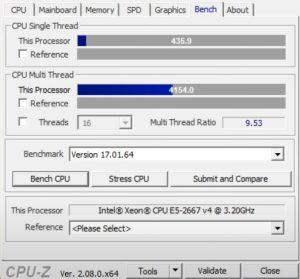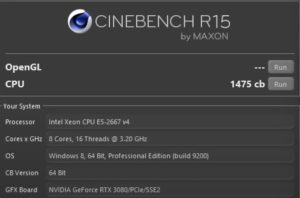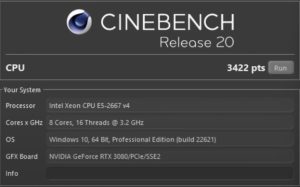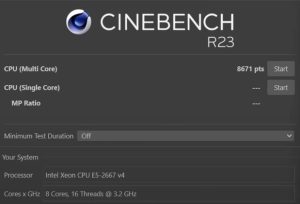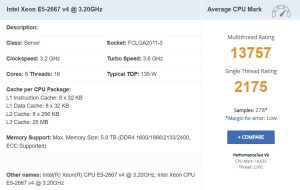Table of Contents
Xeon E5 2667 v4 is one of the most interesting processors for home use. Originally, this model was designed for workstations, which is why it received a fairly high clock frequency. At launch, the processor cost over $2000, and now it’s available to everyone and can be used as the foundation for a budget gaming PC.
Let’s see how good one of the highest-frequency Xeons is in 2025.
Specifications
| Model | Xeon e5 2667 v4 |
|---|---|
| Socket | LGA2011-3 |
| Release Date | Q1 2016 |
| Architecture | Broadwell-EP, 14 nm |
| Cores / Threads | 8 / 16 |
| Memory support | DDR4-2400, 4-channel |
| Base Frequency | 3200 MHz |
| Max Turbo Frequency | 3600 MHz (1-2 Cores) 3500 MHz (3-8 Cores) |
| Extensions & Features | MMX instructions SSE / Streaming SIMD Extensions SSE2 / Streaming SIMD Extensions 2 SSE3 / Streaming SIMD Extensions 3 SSSE3 / Supplemental Streaming SIMD Extensions 3 SSE4 / SSE4.1 + SSE4.2 / Streaming SIMD Extensions 4 AES / Advanced Encryption Standard instructions AVX / Advanced Vector Extensions AVX2 / Advanced Vector Extensions 2.0 BMI / BMI1 + BMI2 / Bit Manipulation instructions F16C / 16-bit Floating-Point conversion instructions FMA3 / 3-operand Fused Multiply-Add instructions EM64T / Extended Memory 64 technology / Intel 64 HT / Hyper-Threading technology VT-x / Virtualization technology VT-d / Virtualization for directed I/O TBT 2.0 / Turbo Boost technology 2.0 TSX / Transactional Synchronization Extensions NX / XD / Execute disable bit ? TXT / Trusted Execution technology Enhanced Intel SpeedStep technology |
| L3 Cache | 25 Mb |
| PCIe Lanes | 40, Gen 3.0 |
| TDP | 135 W |
| Maximum operating temperature | 78°C |
| Multiplier | Locked |
| Integrated Graphics | None |
| CPUID | 0x406F1 |
| Approximate Price | $20 - $25 |
- Good level of single-core performance
- Sufficient number of cores, decent multi-threading
- Doesn’t drop frequency when using AVX instructions
- Affordable price
Main disadvantages:
- Already quite old architecture, low IPC compared to current ones
- Maximum memory frequency of only 2400 MHz (though it supports quad-channel)
- You’ll need to spend money on a proper tower cooler
- Not designed for budget motherboards
It’s worth noting that despite the fairly impressive TDP, real power consumption in typical tasks usually doesn’t exceed 80-100W. Although we don’t recommend using the E5 2667 v4 on very budget boards with weak VRM, the processor can still be considered relatively undemanding. Most mid-range Chinese motherboards can work with this model without problems.
Overclocking Capability
The processor has a locked multiplier, which prevents overclocking for most users. Only some branded boards from the LGA2011-3 heyday can slightly raise the bus frequency, increasing overall frequency by 3-5%, but such overclocking cannot change the overall picture.

Note that Turbo Boost Unlock is only possible on Haswell (V3) processors, but in this case all cores already work at almost maximum possible frequency.
Performance and Tests
E5 2667 v4 received a fairly high frequency, which positively affected the level of single-threaded performance – a weak point of the series. Although the lag behind more modern architectures is still noticeable, in many tasks the processor shows itself much more confidently than multi-core Xeons with low frequency.
CPU-Z
Cinebench R15, R20, R23
Passmark
3DMark Time Spy
Aida64 Cpu-Queen
Gaming Performance
High frequency (within the socket) makes the processor one of the most successful gaming solutions. It’s capable of showing comfortable FPS in most esports projects, and many heavy single-player games also run quite well. Essentially, E5 2667 v4 shows practically maximum gaming performance possible for locked processors on LGA2011-3.
- Games up to 2020: 95% run well (60+ FPS), 5% are playable (40-60 FPS)
- Games 2020-2025: 80% run well (60+ FPS), 10% are playable (40-60 FPS), 10% are unplayable (low FPS, stutters, micro-freezes).
Most suitable graphics cards for FullHD and 1440p: Nvidia 1070 (TI), 1660 (TI\Super), 2060 (Super), 3060 (TI), AMD RX 5600 (XT), RX 5700 (XT), RX 6600 (XT), RX 7600 (XT).
Gaming performance with RTX 3070:
Gaming performance with RX 7900XT and comparisons with Core i3 12100F:
Close Alternatives
High-frequency processors with 8+ cores:
- Xeon E5 1660 V4 – closest 8-core in specifications, slightly inferior in frequency and has less L3 cache
- Xeon E5 2687W v4 – 12 cores, slightly lower frequency, more demanding on motherboard VRM
- Xeon E5 2690 v4 – 14 cores, slightly lower frequency
- Xeon E5 2689 v4 – 10 cores, higher frequency, but very high TDP and price
Here you can view the complete list of processors for LGA2011-3.
Revisions
Besides the final version, there are also engineering versions of the E5 2667 v4. They can be distinguished by the s-spec code, which is engraved on the processor lid. The final version has the code SR2P5. The revision can also be determined by the HWiNFO utility.
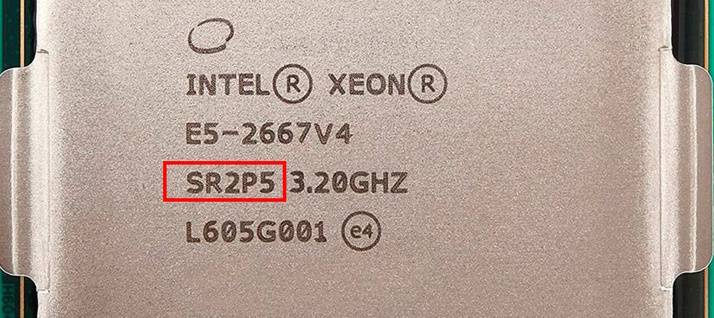
| S-spec Code | Stepping | Version |
| QHVD | ? | ES |
| QKF0 | R0 | QS\ES |
| SR2P5 | R0 | Final |
Frequently Asked Questions
Is undervolting possible?
Only for QS models, in final versions the ability to undervolt is blocked.
Is there solder or thermal paste under the heat spreader?
There’s solder under the heat spreader, as with the entire Xeon E5 v3\v4 lineup.
Is the processor compatible with Win11?
No, the Xeon E5-2667 v4 is not officially supported by Windows 11, but it works fine if you bypass the CPU and TPM checks during installation.

